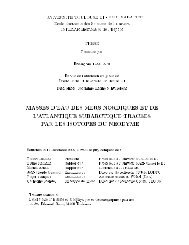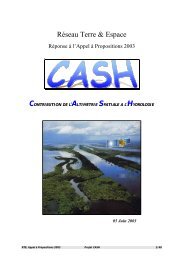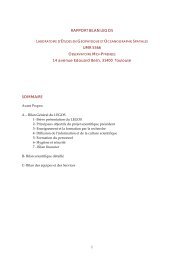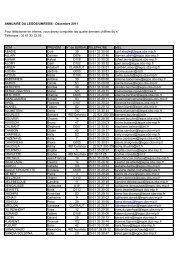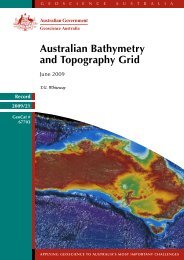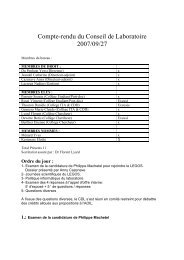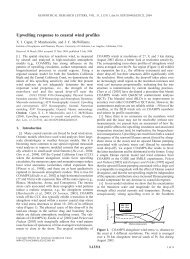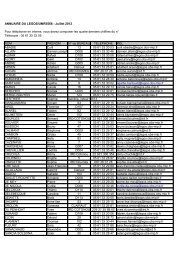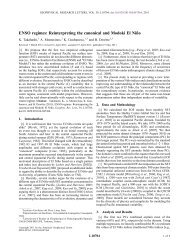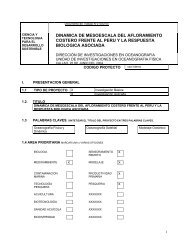Chaigneau and Pizarro - LEGOS
Chaigneau and Pizarro - LEGOS
Chaigneau and Pizarro - LEGOS
You also want an ePaper? Increase the reach of your titles
YUMPU automatically turns print PDFs into web optimized ePapers that Google loves.
C05014 CHAIGNEAU AND PIZARRO: CIRCULATION OF THE EASTERN SOUTH PACIFIC<br />
Figure 9. Horizontal (a, b) heat <strong>and</strong> (c, d) salt fluxes in the 50 m surface layer, associated with the (left)<br />
diffusive turbulent flow <strong>and</strong> with the (right) large-scale surface advection. Numbers indicated in black are<br />
the averages of the corresponding fluxes in the whole study region. The black dashed lines are situated<br />
3° offshore.<br />
horizontal advective salt flux is highly negative (< 50 g<br />
m 2 d 1 ) everywhere except locally, where patches of<br />
positive values are encountered. On average, the horizontal<br />
turbulent flow provides salt to the surface layer at a rate of<br />
12.3 g m 2 d 1 , whereas the horizontal advective flux<br />
freshens it at a rate of 56 g m 2 d 1 . The strong coastal<br />
horizontal heat <strong>and</strong> salt fluxes are due to important meridional<br />
temperature <strong>and</strong> salinity fronts (Figure 8) generated by<br />
the coastal upwelling of colder, fresher subsurface water.<br />
[40] In order to better quantify the respective roles that<br />
advection <strong>and</strong> diffusion play in horizontal temperature <strong>and</strong><br />
salinity mixed layer changes, Figure 10 shows the zonally<br />
averaged meridional variations of heat <strong>and</strong> salt fluxes<br />
between the coast <strong>and</strong> 3° offshore. This cross-shore (perpendicular<br />
to the coast) turbulent heat flux is positive all<br />
along the coast with a mean value of around 25 W m 2 .In<br />
contrast, south of 12°S, the horizontal advective heat flux<br />
associated with the mean currents is negative <strong>and</strong> cools the<br />
surface layer at a rate of 15 W m 2 . Thus along the coast,<br />
the surface mesoscale turbulent flow totally counterbalances<br />
the cooling of the ocean surface by the mean horizontal<br />
large-scale circulation. Between 17°S <strong>and</strong> 27°S, diffusive<br />
heat flux increases to 50 W m 2 <strong>and</strong> is the dominant<br />
horizontal oceanic process providing heat to the surface<br />
layer; the horizontal advective heat flux plays a minor role<br />
in this region. In terms of salt flux, advection <strong>and</strong> diffusion<br />
have an inverse relationship except north of 17°S. On<br />
average, the coastal turbulent flow increases the salinity of<br />
the surface layer at a rate of around 50 g m 2 d 1 , whereas<br />
14 of 17<br />
C05014<br />
the advection of fresher water produces a negative salt flux<br />
on the order of 30 g m 2 d 1 . Again, between 17°S <strong>and</strong><br />
27°S, the salt flux due to mesoscale turbulence increased to<br />
100–120 g m 2 d 1 .<br />
[41] This section has principally shown that coastal lateral<br />
eddy fluxes in the mixed layer are around two times larger,<br />
in absolute value, than the horizontal transport associated<br />
with large-scale advection. However, the budget is not<br />
closed <strong>and</strong> other contributions, such as vertical advection<br />
<strong>and</strong> diffusion, entrainment, <strong>and</strong> outgoing solar fluxes at the<br />
base of mixed layer, may also play a significant role in the<br />
property evolutions. Furthermore, the results presented here<br />
are a crude estimate of the impact of lateral processes on the<br />
mixed layer temperature <strong>and</strong> salt changes. Some errors are<br />
certainly made by considering, for example, a homogeneous<br />
mixed layer of 50 m to be representative of the whole study<br />
area, or homogeneous diffusivities. Owing to the little<br />
hydrographic data available for the region, WOA climatology<br />
may have also introduced several biases into our<br />
calculations. Thus more estimates are needed, based for<br />
example on numerical simulations, to more precisely quantify<br />
the lateral fluxes due to both the large-scale advection<br />
<strong>and</strong> the turbulent flow in the study region.<br />
6. Summary <strong>and</strong> Conclusion<br />
[42] The goal of this study was to describe the mean<br />
surface circulation <strong>and</strong> the turbulent characteristics of<br />
the flow in the eastern South Pacific. On the basis of a





